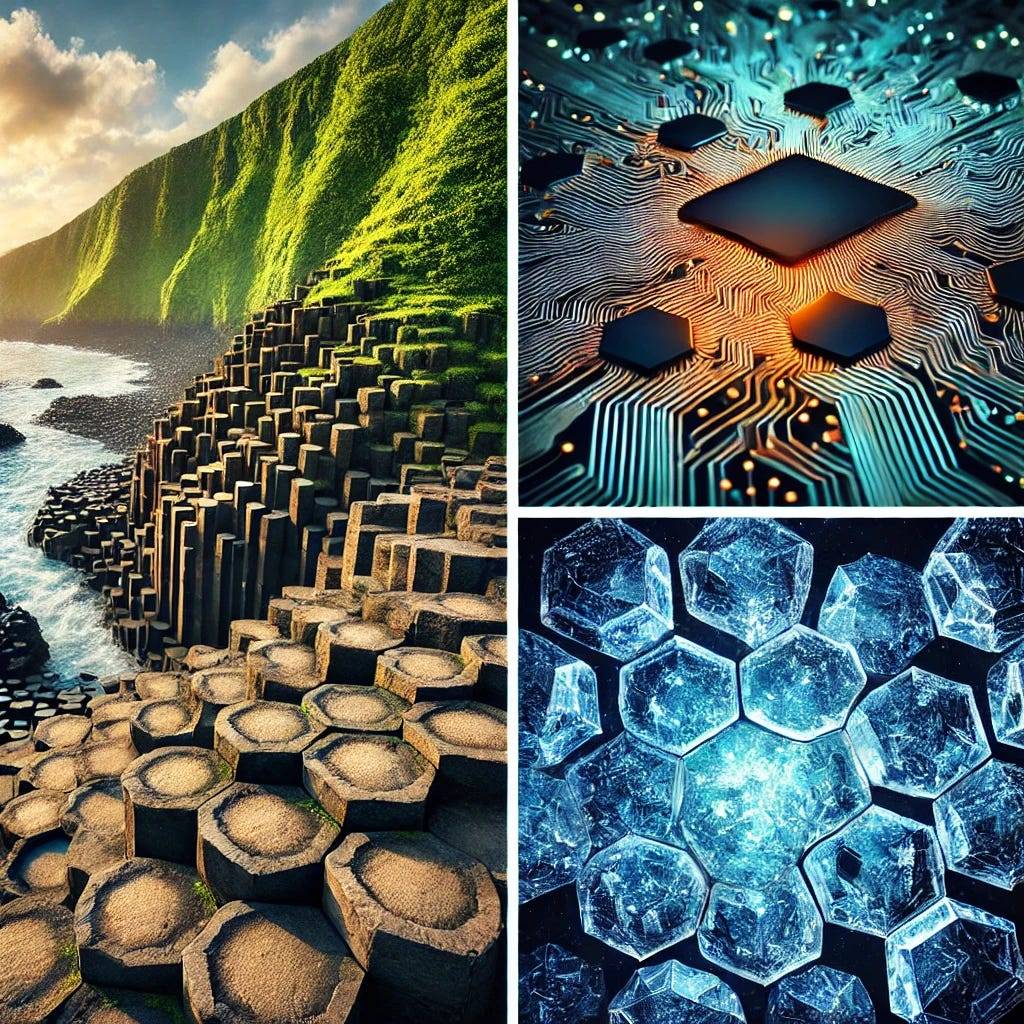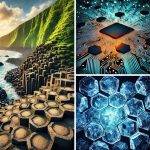
Decoding the Science Behind Honeycomb Patterns
Why do honeycomb-like patterns dominate the natural world? From beehives to basalt columns, these tessellated structures are a stunning mix of beauty and efficiency. Honeycomb patterns, often seen in nature, showcase energy efficiency. While they’re often attributed to energy minimization, many of these shapes come from complex processes rather than perfection. The secret lies in how mathematics, physics, and biology interact. These patterns — whether in beehives or basalt formations — offer deep insights into nature’s designs and low-energy clusters. They remind us that efficiency and adaptability can coexist beautifully. Exploring these formations reveals not only their scientific underpinnings but also the ways they inspire technological innovation. From the smallest cellular structure to the vastness of geological formations, these patterns are a testament to nature’s creative engineering.
The Fascination with Hexagons
Hexagons: Nature’s Signature Shape
Hexagons have fascinated people for centuries. These patterns efficiently tile a plane, using minimal boundary length. Nature often favors hexagons for this reason. Geological formations like Giant’s Causeway show dynamic hexagonal columns formed through processes like cooling lava. The compound eyes of insects also showcase cells that look like hexagons, shaped by biological constraints. The principle of isoperimetry explains this — ensuring the largest area is covered with the smallest perimeter. This section sets the stage for understanding why not all hexagons are perfect and explores the almost-honeycomb structures we often see. Hexagons demonstrate how nature often finds the sweet spot between beauty and utility. The elegance of hexagons lies not just in their geometry but in their adaptability — showing how nature leverages this shape across countless contexts to solve problems efficiently.
Understanding Low-Energy Planar Clusters
Low-Energy Clusters: Beyond Perfect Symmetry
Many clusters in nature resemble honeycomb patterns but are not perfect. These low-energy clusters form in systems where energy constraints guide the structure but don’t enforce precision. Mathematicians have expanded Thomas Hales’ famous theorem to study these clusters. For larger systems, called “N-chambers,” most shapes resemble hexagons, but some irregular shapes emerge. These deviations, or defects, can be measured to see how close a configuration comes to a perfect honeycomb. These findings reveal an underlying order in systems like biological tissues and foams, where geometry meets practicality. By embracing these imperfections, scientists can better understand how constraints shape natural designs. Studying these clusters helps bridge the gap between ideal mathematical models and the reality of natural systems, offering insights into everything from cell organization to the design of synthetic materials.
The Role of Perimeter and Area in Geometric Efficiency
Measuring Efficiency: The Perimeter-Area Trade-off
The balance between perimeter and area is key to understanding honeycomb structures. Hexagons or near-hexagons achieve incredible efficiency. A useful way to see this is through a graph showing how perimeter relates to area for different polygons. Below is an example:

This balance explains why hexagons are favored in nature — their ability to use the least energy while covering the most space. The concept is not just theoretical; it applies to practical designs in architecture and even computing systems. Engineers and scientists often look to this principle when developing technologies that require optimal space utilization. Whether designing compact storage solutions or creating resilient structures, the lessons from hexagonal efficiency are invaluable.
How Machines Learn from Hexagons
Honeycomb patterns inspire machine learning algorithms, optimizing networks and organizing spatial data efficiently. These patterns ensure that resources are used in the most efficient way possible, mimicking nature’s designs in software and hardware. By emulating these principles, engineers can create systems that process data faster and with greater reliability.
Beehives: More Than Just Wax
Bees naturally create almost-perfect hexagons, balancing energy use and structural strength. This instinctive process ensures that their hives are both durable and spacious, demonstrating how animals can instinctively engineer efficiency. The ability of bees to construct such precise structures using minimal resources continues to intrigue researchers.
Geology’s Geometry
Iceland’s basalt columns form hexagonal patterns as lava cools, shaped by thermal stress. These patterns tell the story of Earth’s natural processes, with every column bearing the marks of its cooling history. Geologists use these formations as natural records of volcanic activity, unraveling Earth’s geological past.
From Biology to Architecture
The design of insect eyes and futuristic buildings uses the same geometric principles as honeycombs. Architects and engineers study these patterns to create structures that are both lightweight and strong. By leveraging this knowledge, designers are able to create more sustainable and efficient architectural solutions.
Defects That Tell a Story
Irregularities in honeycomb structures reveal their history and the environmental forces that shaped them. These deviations can be thought of as the fingerprints of a system’s past, offering insights into its formation and adaptation. Scientists use these irregularities to track the environmental conditions that influenced their creation.
Hidden Patterns in Ice Crystals
In freezing conditions, hexagonal shapes appear in snowflakes and ice formations. These crystalline structures reflect the molecular symmetry of water, showcasing nature’s tendency toward elegance. Studying these patterns also provides critical insights into climate science and weather prediction.
Efficient Packing in Nature
Seeds, such as those in sunflowers, arrange themselves in spirals and patterns that mirror hexagonal packing principles. This packing maximizes space, ensuring that every seed gets the sunlight it needs. This efficiency has even inspired innovations in agriculture and horticulture, helping farmers optimize crop yields.
Hexagons in Modern Technology:
From smartphone batteries to advanced nanotechnology, hexagonal patterns are being used to create more efficient and durable devices. These modern applications demonstrate how age-old natural principles are still relevant in cutting-edge technology.
Towards a Unified Theory of Patterns in Nature
Honeycomb-like structures show how nature balances efficiency with adaptability. These patterns aren’t always perfect, but they’re incredibly functional. They remind us that imperfection can be an advantage. By studying the mathematics and physics of these formations, we can apply these ideas to technology, materials, and even urban planning. The future lies in learning from nature’s elegant and efficient designs. As researchers continue to uncover these patterns, we unlock tools to solve some of humanity’s most pressing challenges, from sustainable construction to resource management. Through interdisciplinary collaboration, these discoveries are paving the way for a new era of design and innovation inspired by nature’s genius.
About Disruptive Concepts
Welcome to @Disruptive Concepts — your crystal ball into the future of technology. 🚀 Subscribe for new insight videos every Saturday!
See us on https://twitter.com/DisruptConcept
Read us on https://medium.com/@disruptiveconcepts
Enjoy us at https://disruptive-concepts.com
Whitepapers for you at: https://disruptiveconcepts.gumroad.com/l/emjml
New Apps: https://2025disruptive.netlify.app/







